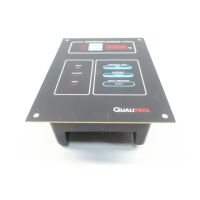Electronic Temperature Monitor
ECN-27644 6 July 7, 2010
Primary Power
Primary Power is connected to TB3-3 and TB3-4 with an Earth Ground
connection to TB2-11. This connection provides power to the 118 unit and to the
contact of Fan Control Relay #1. If the dual fan relay option is provided then the
power for Fan Control Relay #2 is connected to TB3-7 and TB3-8. See Figure 3;
Wiring Diagram.
NOTE: Jumpers on TB2-7,8,9,10 must be set to match the Primary voltage being
used. For 120 VAC, connect TB2-7 & 8 and connect TB2-9 & 10. For
230/240 and 277 VAC, connect TB2-8 & 9. Note: the 277 VAC units
have some internal differences - DO NOT connect 277 VAC to a
120/230/240 VAC unit.
Sensors
The three thermocouple sensors are connected to TB1-1(+), 2(-); TB1-3(+), 4(-)
and TB1-5(+), 6(-). See Figure 3; Wiring Diagram.
To connect the Type K thermocouples, the YELLOW lead is connected to the
positive terminal (1,3 or 5) and the RED lead is connected to the negative terminal
(2,4 or 6).
If no thermocouple is connected to an input, those input terminals must be shorted
together. This will prevent the ETM from reporting an alarm condition due to a
failed input, and will cause that channel to show the internal temperature of the
ETM. If the channel is not used, it can be turned OFF using the setup software,
but the terminals still need to be shorted together.
Relay Contacts
FAN #1 - The #1 fan contacts are internally connected to the primary power
through a 20A fuse internal to the ETM. Connect the #1 Fans to TB3-1 & 2.
FAN #2 - If the optional second fan relay is installed, it controls Fans through a
20A fuse connected to TB3-5 & 6. Note, the #2 Fan circuit is electrically separate
from the #1 Fan circuit and is powered from TB3-7 & 8
ALARM - SPDT (form C) contacts are provided at TB2-1, 2 & 3 to indicate an
alarm condition. This relay is usually set to be energized in the normal state so
that the power off state will cause an alarm (Fail Safe). Jumpers on the PCB set
the normal state of the relay.
NOTE: Under normal conditions below setpoint, TB2-1&2 are closed and
TB2-2&3 are open. Under alarm condition, TB2-2&3 will close.
TRIP - SPDT (form C) contacts are provided at TB2-4, 5 & 6 to indicate that the
temperature being monitored has reached the trip state. This relay is usually set to
be de-energized in the normal (non-failsafe) state. The normal state of the relay is
set by software via the RS-232 port.
NOTE: Under normal (default) conditions below setpoint, TB2-4&5 are open
and TB2-5&6 are closed. Under alarm conditions, TB2-4&5 will
Courtesy of NationalSwitchgear.com

